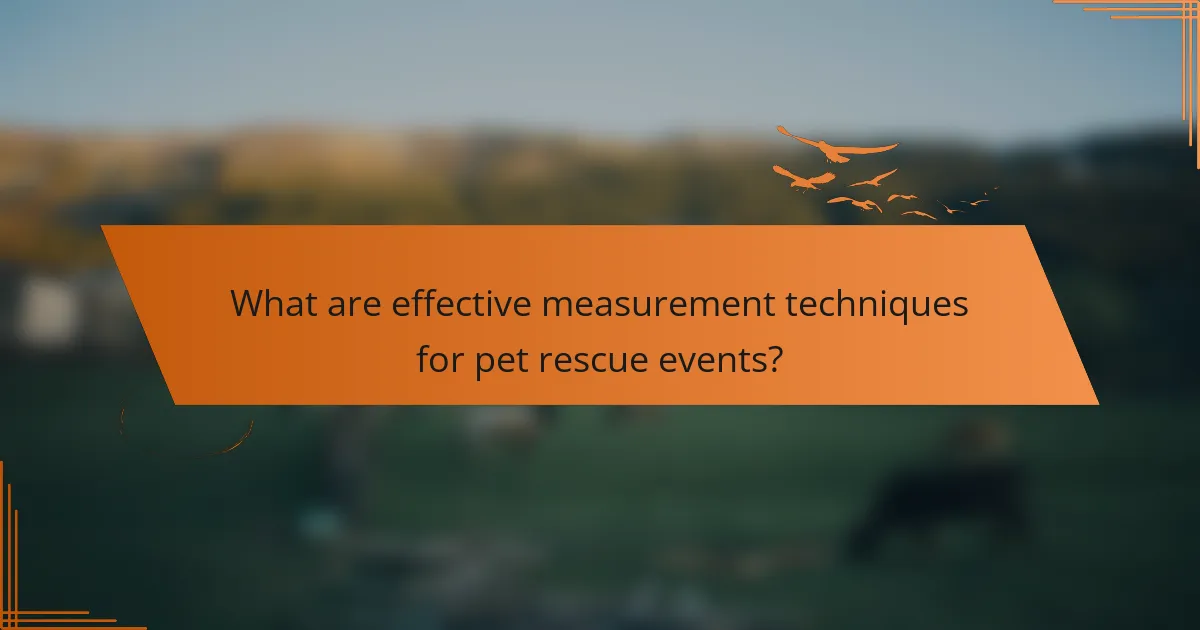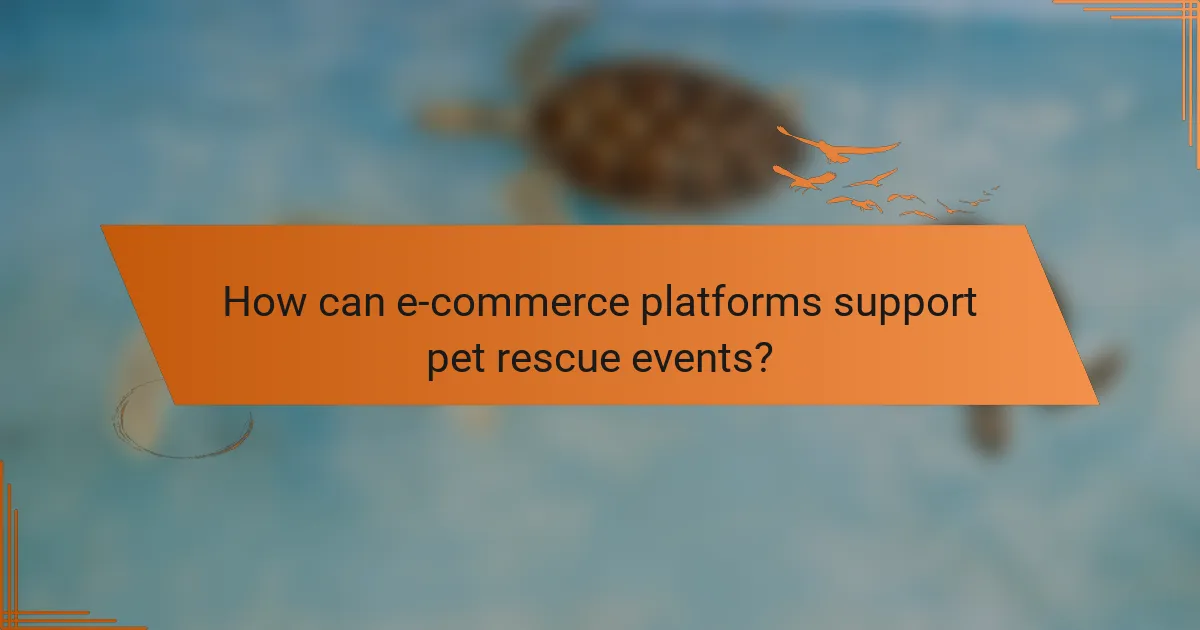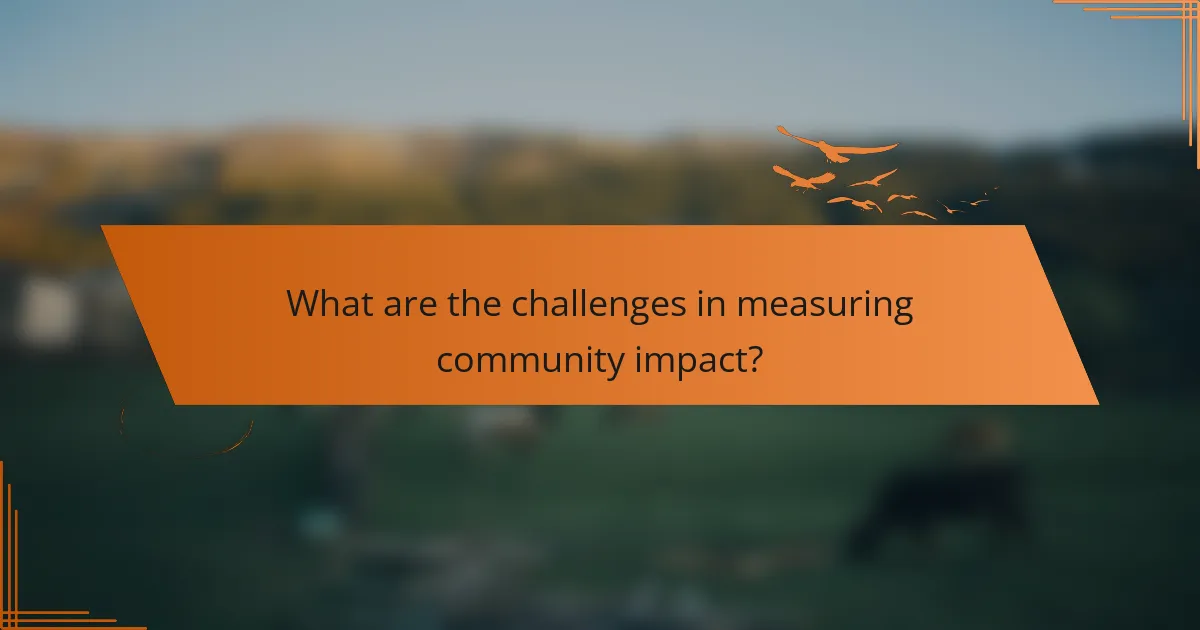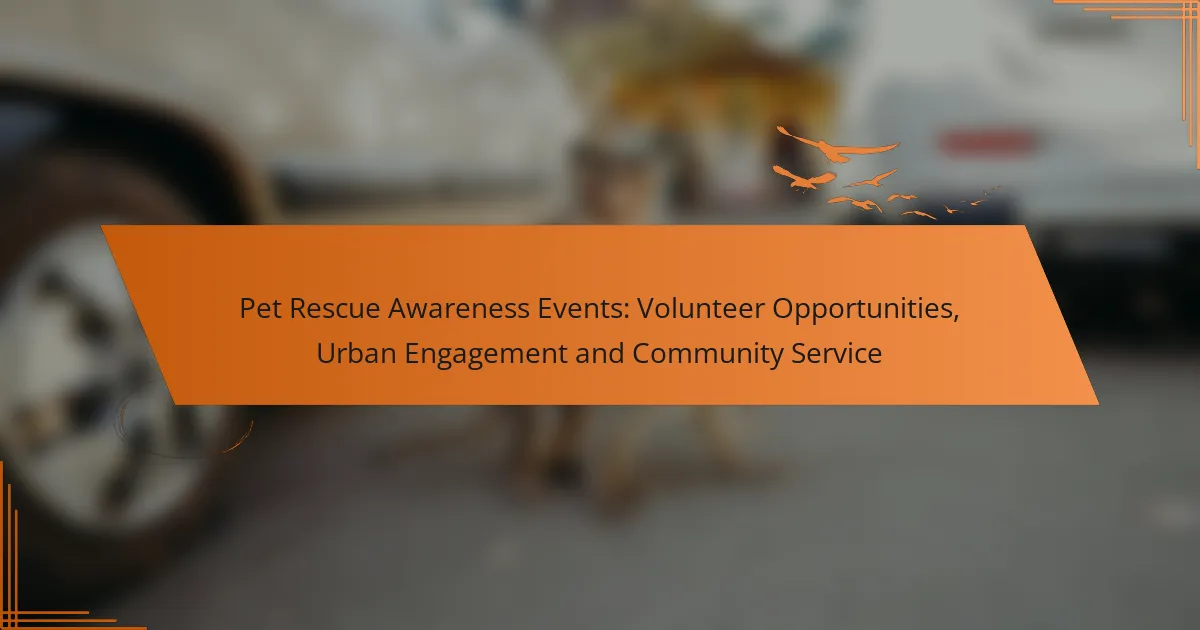Pet rescue awareness events play a vital role in enhancing community engagement and promoting animal welfare by encouraging pet adoption and educating the public. These initiatives not only connect local shelters with residents but also foster a more compassionate environment for animals in need. By employing effective measurement techniques and tracking success indicators, organizations can assess the impact of these events and continuously improve their outreach efforts.

How do pet rescue awareness events impact communities?
Pet rescue awareness events significantly enhance communities by promoting animal adoption, fostering engagement, and increasing public knowledge about pet welfare. These events create a platform for local shelters and organizations to connect with residents, ultimately leading to a more compassionate and informed community.
Increased adoption rates
Pet rescue awareness events often lead to higher adoption rates by showcasing animals in need of homes. By providing a space for potential adopters to meet pets, these events can facilitate emotional connections that encourage adoption.
For example, during a weekend adoption fair, shelters may see a surge in interest, with adoption rates increasing by 20-30% compared to regular weekends. Offering incentives like reduced fees or free starter kits can further boost these numbers.
Enhanced community engagement
These events foster community engagement by bringing together pet lovers, volunteers, and local businesses. Activities such as pet parades, contests, and educational workshops create a lively atmosphere that encourages participation.
Engagement can be measured through attendance numbers and volunteer sign-ups, with successful events often attracting hundreds of participants. Collaborating with local businesses for sponsorships can also enhance community ties and support.
Improved public awareness
Pet rescue awareness events play a crucial role in educating the public about animal welfare issues. They provide information on responsible pet ownership, the importance of spaying/neutering, and the benefits of adopting over buying pets.
Distributing brochures, hosting talks, and using social media can amplify the reach of these messages. Events that include guest speakers or demonstrations can further enhance understanding and retention of information.
Support for local shelters
These events directly benefit local shelters by raising funds and resources. Many awareness events include donation drives, where attendees can contribute food, supplies, or monetary donations to support shelter operations.
Additionally, partnerships with local businesses can lead to sponsorship opportunities, providing shelters with much-needed financial backing. Tracking donations and resources collected during events can help assess their impact on shelter sustainability.

What are effective measurement techniques for pet rescue events?
Effective measurement techniques for pet rescue events include gathering data through surveys, analyzing social media engagement, tracking adoption statistics, and monitoring volunteer participation rates. These methods provide insights into the event’s impact and help organizations refine their strategies for future initiatives.
Surveys and feedback forms
Surveys and feedback forms are essential tools for collecting direct input from attendees and participants. They can assess satisfaction levels, gather suggestions, and identify areas for improvement. Consider using a mix of multiple-choice questions and open-ended responses to capture both quantitative and qualitative data.
Distributing these forms immediately after the event, either digitally or in print, can yield higher response rates. Aim for a completion rate of at least 20-30% to ensure the feedback is representative of the overall experience.
Social media engagement metrics
Social media engagement metrics provide valuable insights into how well your pet rescue event resonated with the community. Track likes, shares, comments, and overall reach to gauge interest and engagement levels. High engagement rates often correlate with increased awareness and support for your cause.
Utilize tools like Facebook Insights or Instagram Analytics to monitor these metrics. Aiming for a 10-15% engagement rate on posts related to the event can indicate successful outreach and community involvement.
Adoption statistics
Adoption statistics are a critical indicator of a pet rescue event’s success. Tracking the number of animals adopted during or shortly after the event can help measure its effectiveness. Compare these figures to previous events to assess growth or identify trends.
Consider setting specific goals, such as increasing adoptions by 20% compared to the last event. This can motivate your team and provide a clear benchmark for success.
Volunteer participation rates
Monitoring volunteer participation rates is crucial for understanding community involvement in pet rescue events. High volunteer turnout can indicate strong community support and engagement. Track the number of volunteers who sign up and participate, as well as their roles during the event.
To enhance participation, consider offering incentives such as recognition, refreshments, or small gifts. Aiming for at least 50% of volunteers to return for future events can signify a positive experience and commitment to the cause.

What success indicators should be tracked?
Tracking success indicators for pet rescue awareness events is crucial for evaluating their impact. Key metrics include the number of pets adopted, community attendance figures, funds raised for local shelters, and media coverage and reach.
Number of pets adopted
The number of pets adopted during an event is a direct measure of its success. This figure can indicate how effectively the event engaged the community and promoted adoption. Tracking this metric helps organizations understand which strategies resonate most with potential adopters.
To enhance adoption rates, consider offering incentives such as reduced adoption fees or free starter kits for new pet owners. Engaging storytelling about the pets can also motivate attendees to adopt.
Community attendance figures
Community attendance figures reflect the level of interest and engagement in the event. A higher turnout often correlates with increased awareness and support for local shelters. Tracking attendance can help organizers assess the effectiveness of their marketing efforts.
To boost attendance, utilize social media campaigns, local partnerships, and community outreach. Setting clear goals for attendance can help measure the event’s growth over time.
Funds raised for local shelters
Funds raised during the event provide essential financial support to local shelters. This metric not only reflects the event’s success but also its ability to mobilize community resources for animal welfare. Tracking funds raised can help organizations plan future events and allocate resources effectively.
Consider incorporating fundraising activities such as auctions, raffles, or donation drives during the event. Clearly communicating how funds will be used can encourage more generous contributions.
Media coverage and reach
Media coverage and reach are vital for amplifying the message of pet rescue awareness events. Positive media attention can significantly increase public awareness and support for local shelters. Tracking this metric involves monitoring articles, social media mentions, and broadcast segments related to the event.
To enhance media coverage, create press releases and engage local influencers. Highlighting compelling stories and unique aspects of the event can attract media interest and broaden your audience reach.

How can e-commerce platforms support pet rescue events?
E-commerce platforms can significantly enhance pet rescue events by providing tools for donations, promoting events, and facilitating partnerships with local shelters. These features not only increase visibility but also streamline the fundraising process, making it easier for communities to support animal welfare initiatives.
Donation integration features
Donation integration features allow e-commerce platforms to seamlessly accept contributions during checkout or through dedicated fundraising pages. This can include options for one-time donations or recurring contributions, which can appeal to different donor preferences.
Platforms can also implement features like matching donations, where businesses match customer contributions, effectively doubling the impact. Clear calls-to-action and visible donation buttons can encourage more users to participate, increasing overall fundraising success.
Event promotion tools
Event promotion tools enable e-commerce platforms to advertise pet rescue events through various channels, including social media, email newsletters, and website banners. These tools can help reach a wider audience, attracting more participants and potential donors.
Utilizing targeted advertising can also maximize outreach by focusing on users who have previously shown interest in animal welfare. Additionally, offering incentives, such as discounts or exclusive merchandise for event participants, can further boost engagement.
Partnership opportunities with shelters
Partnership opportunities with local shelters can enhance the credibility and reach of pet rescue events. E-commerce platforms can collaborate with shelters to co-host events, share resources, and cross-promote each other’s initiatives.
These partnerships can also include sponsorships, where e-commerce businesses provide financial support or in-kind donations in exchange for visibility at events. Building strong relationships with shelters not only benefits the events but also fosters a community spirit around animal rescue efforts.

What are the best practices for organizing pet rescue awareness events?
Effective pet rescue awareness events require strategic planning, community involvement, and strong promotional efforts. By focusing on collaboration, social media engagement, and influencer partnerships, organizers can maximize their impact and reach.
Collaborating with local businesses
Partnering with local businesses can significantly enhance the visibility and resources of pet rescue awareness events. Businesses can provide sponsorship, venues, or in-kind donations, which can help reduce costs and increase community engagement.
Consider reaching out to pet stores, veterinary clinics, and cafes that allow pets. Creating mutually beneficial arrangements, such as co-hosting events or offering discounts to attendees, can foster stronger community ties and encourage participation.
Utilizing social media for promotion
Social media platforms are essential for promoting pet rescue awareness events effectively. Utilize channels like Facebook, Instagram, and Twitter to share event details, engage with followers, and create buzz around the occasion.
Post regular updates, use eye-catching visuals, and encourage sharing among followers. Hashtags related to pet rescue and local community events can help expand reach. Aim to create a content calendar leading up to the event to maintain consistent engagement.
Engaging local influencers
Local influencers can amplify the message of pet rescue awareness events by leveraging their established audiences. Collaborating with pet bloggers, animal advocates, or community figures can bring credibility and attract more attendees.
Reach out to influencers who align with your cause and offer them incentives, such as free event access or promotional materials. Their endorsements can significantly increase awareness and participation, making your event more successful.

What are the challenges in measuring community impact?
Measuring community impact can be complex due to various factors, including the difficulty in quantifying emotional and social benefits. Additionally, the diverse nature of community engagement makes it challenging to establish clear metrics that accurately reflect the effectiveness of pet rescue awareness events.
Defining Success Indicators
Success indicators are specific metrics used to evaluate the effectiveness of pet rescue awareness events. Common indicators include the number of pets adopted, community participation rates, and the amount of funds raised for local shelters. Establishing clear success indicators helps organizations focus their efforts and assess their impact more effectively.
Data Collection Techniques
Effective data collection techniques are crucial for measuring community impact. Surveys, interviews, and social media analytics can provide valuable insights into community engagement and sentiment. For instance, post-event surveys can gauge participant satisfaction and gather feedback on areas for improvement.
Challenges in Data Interpretation
Interpreting data can present challenges due to varying community dynamics and external factors. For example, an increase in adoptions may not solely reflect the success of an event but could also be influenced by seasonal trends or local economic conditions. It’s essential to consider these variables when analyzing results.
Long-term Impact Assessment
Assessing long-term impact requires ongoing evaluation beyond immediate outcomes. Tracking metrics over time, such as repeat participation in events or sustained community support for local shelters, can provide a clearer picture of lasting change. Organizations should aim for regular follow-ups to understand the enduring effects of their initiatives.



